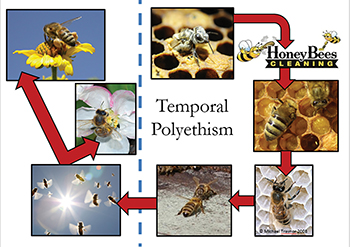
Here are many different types of jobs in a honey bee hive. Cells need to be cleaned and polished, so the queen can lay eggs. The rapidly developing larvae need brood food. To survive, the colony requires both nectar and pollen. Returning foragers carrying loads of nectar or water need to be unloaded, so they can head back out into the field. Pollen pellets must be kicked off into empty or partially filled cells and tamped down into bee bread. Bees need propolis, for which foragers collect resin and mix it with enzymes and wax. The colony is often a continuous teeming mass of bees, occupied in a variety of tasks depending on the time of day, the season, and the colony’s condition.
How do worker bees know what to do and when to do it? There is a natural progression in honey bee task allocation from the time they emerge. Workers shift through different jobs in a set order, although there is flexibility in the timing of those transitions. Scientists call this age related task shifting temporal polyethism. The rate at which bees switch from one stage to the next is flexible. The timing of transition is influenced by hormonal differences, such as levels of juvenile hormone (JH) and vitellogenin (VG), or physiological differences like worker ovary size. It is also strongly influenced by external conditions, like the number of foragers and newly emerged bees, the amount of brood in the colony, and how much pollen the hive has stored.
Temporal polyethism thus permits the colony to allocate risky tasks such as hive defense and foraging to the oldest workers. Once bees engage in foraging, they are at much greater risk of dying from predation or unfavorable elements. Bees that transition to foraging at younger ages, typically also die at younger ages. So age polyethism helps maximize a worker bee’s effective lifetime.
Bees typically only move in one direction, from inside hive tasks to the more dangerous outside tasks. However, if all of the nurse bees are artificially removed, older foragers can revert back to nursing to fill the void. When foragers are lost, young bees speed through and become precocious foragers.
Newly emerged bees are pretty defenseless. They can’t yet sting or fly. They spend the first 1-3 days of their adult life cleaning cells, grooming, with large bouts of being motionless. It’s not unusual to spot them headfirst in an empty cell, completely immobile, almost as if they were in there for a snooze.
The bees consume pollen to activate the hypopharyngeal glands in their head and transition to brood rearing, feeding brood food to the developing larvae. The nursing stage lasts for about a week, from approximately 4-12 days of age. Again there is a lot of variance in task shifting between workers. During this phase, the nurses will also feed other adult bees and the queen, helping to regulate her rate of egg laying through feedings.
From there the bees shift to middle age tasks, which keep them spread throughout the hive, typically building new comb and repairing old. They then transition to receiving and processing incoming nectar, helping to unload incoming nectar and water foragers. They also evaporate off moisture from the nectar, adding enzymes that help split complex sugars into simple sugars. Bees typically engage in ….


